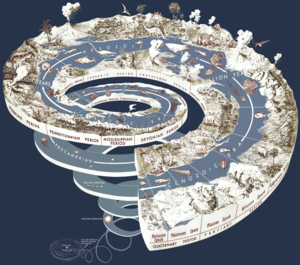
Back Geochronologie Afrikaans علم الزمن الجيولوجي Arabic Geoxronologiya Azerbaijani Геохронология Bashkir Геахраналогія Byelorussian Геохронология Bulgarian Geohronologija BS Geocronologia Catalan Dê-cék nièng-dô̤i-hŏk CDO Geochronologie Czech

Geochronology is the science of determining the age of rocks, fossils, and sediments using signatures inherent in the rocks themselves. Absolute geochronology can be accomplished through radioactive isotopes, whereas relative geochronology is provided by tools such as paleomagnetism and stable isotope ratios. By combining multiple geochronological (and biostratigraphic) indicators the precision of the recovered age can be improved.
Geochronology is different in application from biostratigraphy, which is the science of assigning sedimentary rocks to a known geological period via describing, cataloging and comparing fossil floral and faunal assemblages. Biostratigraphy does not directly provide an absolute age determination of a rock, but merely places it within an interval of time at which that fossil assemblage is known to have coexisted. Both disciplines work together hand in hand, however, to the point where they share the same system of naming strata (rock layers) and the time spans utilized to classify sublayers within a stratum.
The science of geochronology is the prime tool used in the discipline of chronostratigraphy, which attempts to derive absolute age dates for all fossil assemblages and determine the geologic history of the Earth and extraterrestrial bodies.
© MMXXIII Rich X Search. We shall prevail. All rights reserved. Rich X Search